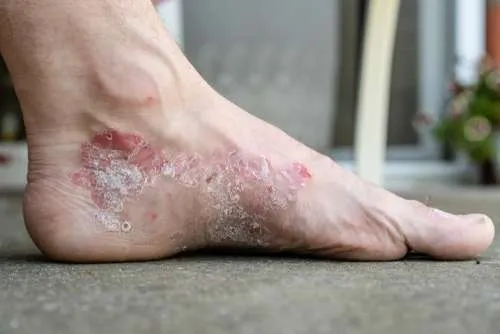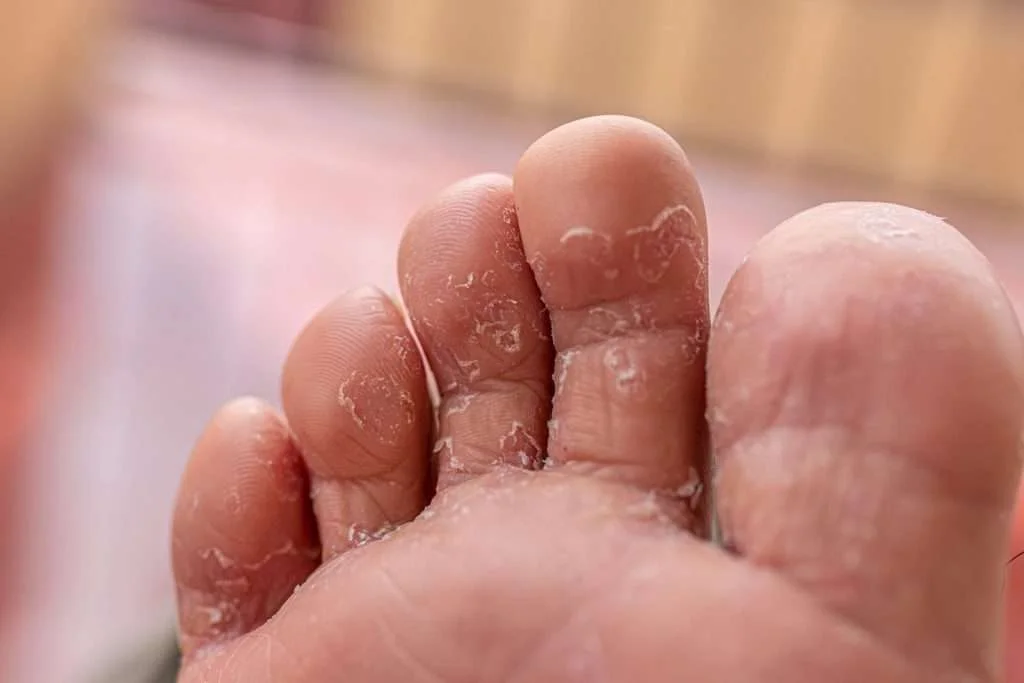Psoriasis
Is it athlete’s foot or psoriasis?
Rashes and red scaly skin are quite common skin conditions that affect many Australians. But when they affect your feet, they can severely impact your life.
The most common cause of irritated skin on the feet is psoriasis and it’s something we see a lot of in our clinic. As experienced, qualified podiatrists, we can diagnose and help you manage this painful and irritating condition.
Read on to learn more about psoriasis, its causes, and how we can help.
What is psoriasis?
Psoriasis is a chronic inflammatory skin condition that typically causes a red, scaly rash. Psoriasis can occur anywhere on the body, including the feet. It is linked to other health conditions including inflammatory arthritis, inflammatory bowel disease (especially Crohn’s disease), uveitis (eye inflammation), and celiac disease (an autoimmune disease that is triggered by the consumption of gluten). People with severe psoriasis also have an increased risk of developing diabetes and cardiovascular disease.
There are several types of psoriasis but the most common is called plaque psoriasis, which affects 85 to 90% of people with psoriasis. Psoriasis that appears on the feet is called plantar psoriasis. When it appears on both hands and feet, it’s known as palmoplantar psoriasis.

Symptoms of foot psoriasis
The symptoms of psoriasis on the feet can differ from person to person. The most common symptoms of plaque psoriasis are:
- raised, red, inflamed patches of skin
- silvery scales (plaques) on the red patches
- dry, bleeding cracked skin
- pain around the red patches
- itching or burning around the patches
- thick, pitted nails
- painful, swollen joints (psoriatic arthritis is linked to psoriasis, but not everyone who has psoriatic arthritis has the skin condition)
Psoriasis can occur anywhere on the feet, including the soles of your feet.
What causes psoriasis?
Psoriasis occurs when skin cells are replaced too quickly. While the exact cause is not fully understood, it’s believed that psoriasis is an autoimmune condition, which means that the immune system attacks healthy tissues (e.g. skin) by mistake.
There is also a genetic predisposition to psoriasis with the condition often running in families.
Some people may notice that certain things can trigger or worsen symptoms. These include:

stress

weather
changes in the weather, especially if it causes skin to dry

infection
being sick or having an infection

injury
a recent injury to the skin such as cut, insect bite or sunburn

medication
How is psoriasis diagnosed?
Diagnosing psoriasis is normally done via a physical examination, as symptoms are usually easy to distinguish from other conditions that cause similar symptoms. However, sometimes it may be necessary to perform a biopsy to confirm a diagnosis. This is where a small sample of skin is taken and sent to a laboratory to be examined under a microscope.
Treatment for foot psoriasis
There is no treatment to cure psoriasis, but there are many things you can do to relieve symptoms and reduce flare-ups.
home treatment
Mild psoriasis can be managed with products applied to the skin. These include:
- moisturisers and emollients (thick barrier creams) applied regularly to moisturise and prevent painful cracking
- products containing urea or salicylic acid designed to thin down the scaly skin
- topical steroid ointments to reduce inflammation, itch and scaling.

Podiatry treatment
Our podiatrists are highly-experienced in diagnosing and treating psoriasis of the feet. Along with providing a diagnosis, we can also recommend the best topical treatments for your condition and how best to care for your feet, based on your symptoms. For more severe psoriasis that doesn’t respond to topical treatments, you may need systemic treatment. These treatments are administered orally or via injections, which we can perform in our clinic.
Other treatment that is often used in conjunction with topical or systemic treatments is phototherapy (light therapy). While we don’t perform this at our clinic, we can provide you with a referral.
Foot psoriasis can be extremely painful and challenging to treat which is why it’s important to seek help as soon as you notice a problem.
Don’t suffer in silence hoping it will get better on its own. Make an appointment to visit one of our friendly podiatrists.
frequently asked questions
No, you can also get Psoriasis on your hands, knees, elbows, scalp, and skin.
Socks which are breathable, and light can be comfortable. There are specialists socks that have gel lining for further cushioning and skin protection.
You can try 1:1 apple cider vinegar and warm water foot soak. Daily for 10minutes.
Engin B, Aşkın Ö, Tüzün Y. Palmoplantar psoriasis. Clin Dermatol. 2017 Jan-Feb;35(1):19-27. doi: 10.1016/j.clindermatol.2016.09.004. Epub 2016 Sep 10. PMID: 27938808.
Merola JF, Qureshi A, Husni ME. Underdiagnosed and undertreated psoriasis: Nuances of treating psoriasis affecting the scalp, face, intertriginous areas, genitals, hands, feet, and nails. Dermatol Ther. 2018 May;31(3):e12589. doi: 10.1111/dth.12589. Epub 2018 Mar 6. PMID: 29512290; PMCID: PMC6901032.
Raposo I, Torres T. Palmoplantar Psoriasis and Palmoplantar Pustulosis: Current Treatment and Future Prospects. Am J Clin Dermatol. 2016 Aug;17(4):349-58. doi: 10.1007/s40257-016-0191-7. PMID: 27113059.
Derancourt C, Van Landuyt H, Laurent R. Le psoriasis palmo-plantaire: diagnostic et stratégie thérapeutique [Palmoplantar psoriasis: diagnosis and therapeutic strategy]. Ann Dermatol Venereol. 1998 Mar;125(3):220-5. French. PMID: 9747257.
Leibovici V, Lemster N, Ramot Y, Siam R, Siam I, Maly A, Strauss-Liviatan N, Hochberg M. Prevalence of interdigital psoriasis of the feet (“psoriasis alba”) in mild, moderate, and severe psoriasis. Int J Dermatol. 2015 Sep;54(9):1084-7. doi: 10.1111/ijd.12810. PMID: 26284463.
Bardazzi F, Antonucci VA, Patrizi A, Alessandrini A, Tengattini V, Odorici G, Balestri R. Interdigital psoriasis of the feet (psoriasis alba): not a distinct form of psoriasis. Dermatology. 2013;227(2):130-3. doi: 10.1159/000352080. Epub 2013 Aug 27. PMID: 23988726.
Psoriasis, Diagnostic Pathology: Nonneoplastic Dermatopathology, 10.1016/B978-0-323-37713-3.50021-2, (32-35), (2017).
Hooper D. Impact of Psoriasis on Women. J Drugs Dermatol. 2019 Sep 1;18(9):950. PMID: 31524995.
Egeberg A, See K, Garrelts A, Burge R. Epidemiology of psoriasis in hard-to-treat body locations: data from the Danish skin cohort. BMC Dermatol. 2020 May 20;20(1):3. doi: 10.1186/s12895-020-00099-7. PMID: 32434510; PMCID: PMC7238562.
Girolomoni G, Gisondi P. Psoriasis and systemic inflammation: underdiagnosed enthesopathy. J Eur Acad Dermatol Venereol. 2009 Sep;23 Suppl 1:3-8. doi: 10.1111/j.1468-3083.2009.03361.x. PMID: 19686379.
Derancourt C, Van Landuyt H, Laurent R. Le psoriasis palmo-plantaire: diagnostic et stratégie thérapeutique [Palmoplantar psoriasis: diagnosis and therapeutic strategy]. Ann Dermatol Venereol. 1998 Mar;125(3):220-5. French. PMID: 9747257.
DermNet NZ, Psoriasis of the palms and soles, https://dermnetnz.org/topics/psoriasis-of-the-palms-and-soles/
Healthdirect, Psoriasis, https://www.healthdirect.gov.au/psoriasis
Healthline, Everything You Need to Know About Psoriasis, https://www.healthline.com/health/psoriasis
Healthline, Is It Psoriasis or Athlete’s Foot? Tips for Identification, https://www.healthline.com/health/psoriasis/psoriasis-or-athletes-foot
Medical News Today, Managing psoriasis on the feet, https://www.medicalnewstoday.com/articles/323663
read this next

Athlete’s foot is a very common condition. Find out what it is, how you prevent it, and what we can do to help you